The Role of Responders, Relevant Legislation and Preparedness
VerifiedAdded on 2024/05/14
|21
|4289
|209
AI Summary
Contribute Materials
Your contribution can guide someone’s learning journey. Share your
documents today.
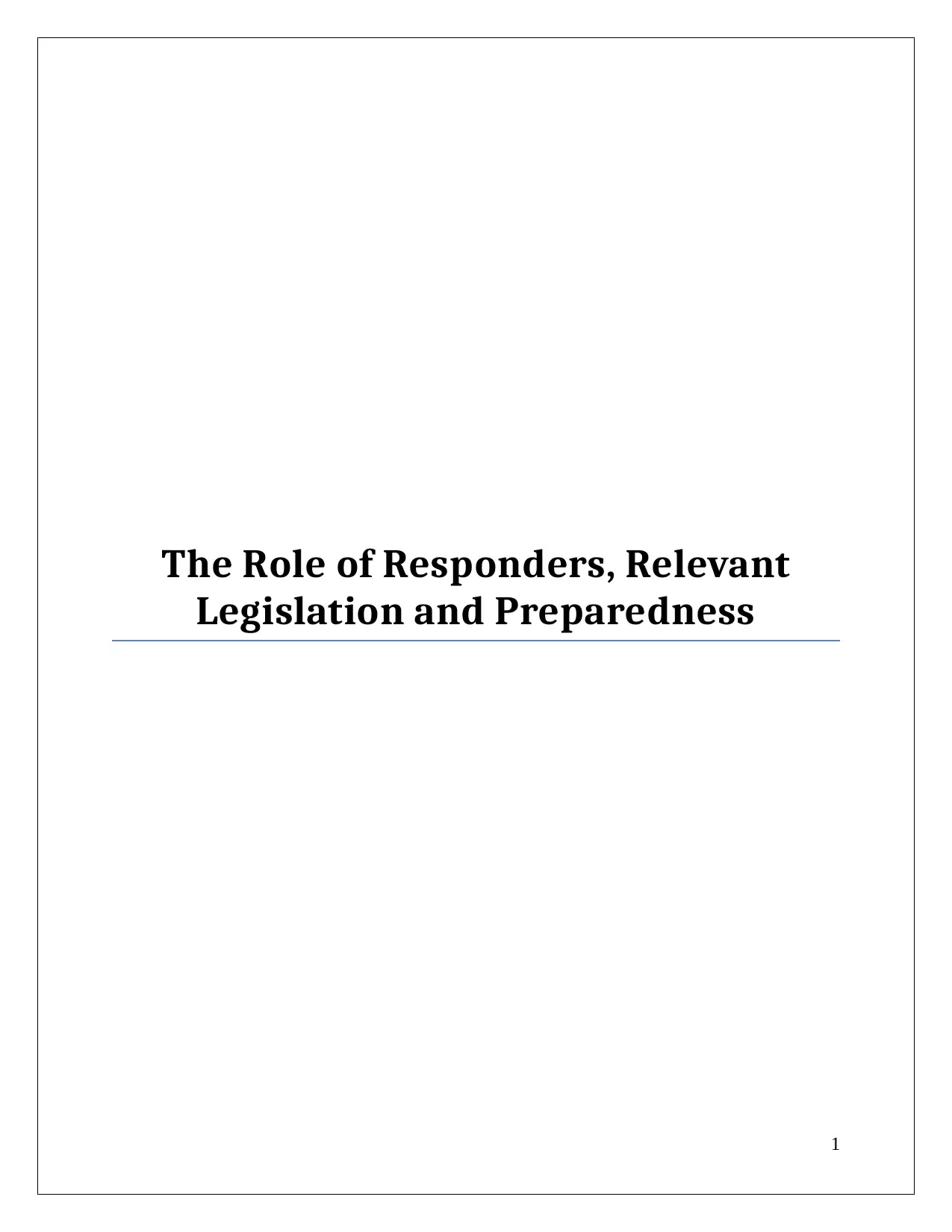
The Role of Responders, Relevant
Legislation and Preparedness
1
Legislation and Preparedness
1
Secure Best Marks with AI Grader
Need help grading? Try our AI Grader for instant feedback on your assignments.
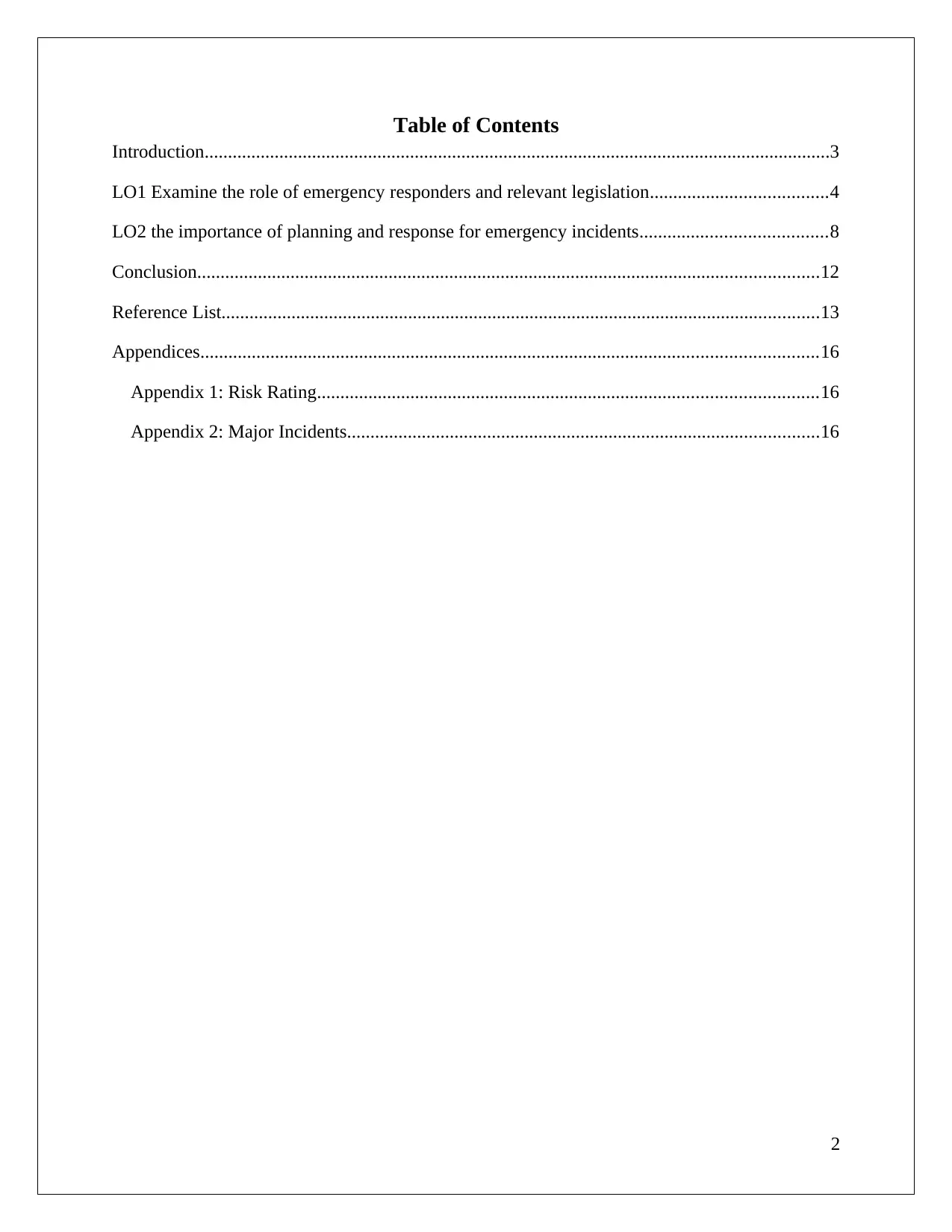
Table of Contents
Introduction......................................................................................................................................3
LO1 Examine the role of emergency responders and relevant legislation......................................4
LO2 the importance of planning and response for emergency incidents........................................8
Conclusion.....................................................................................................................................12
Reference List................................................................................................................................13
Appendices....................................................................................................................................16
Appendix 1: Risk Rating...........................................................................................................16
Appendix 2: Major Incidents.....................................................................................................16
2
Introduction......................................................................................................................................3
LO1 Examine the role of emergency responders and relevant legislation......................................4
LO2 the importance of planning and response for emergency incidents........................................8
Conclusion.....................................................................................................................................12
Reference List................................................................................................................................13
Appendices....................................................................................................................................16
Appendix 1: Risk Rating...........................................................................................................16
Appendix 2: Major Incidents.....................................................................................................16
2
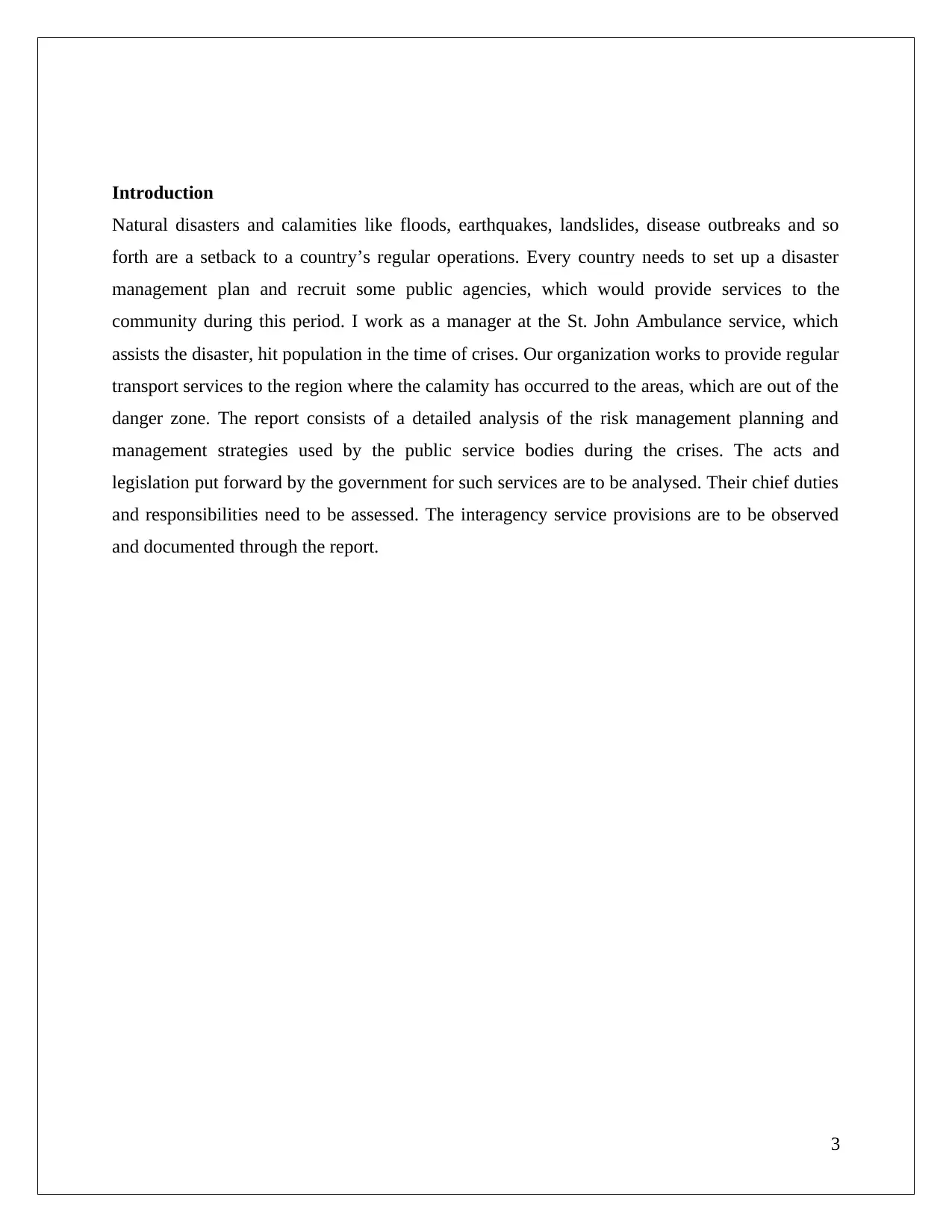
Introduction
Natural disasters and calamities like floods, earthquakes, landslides, disease outbreaks and so
forth are a setback to a country’s regular operations. Every country needs to set up a disaster
management plan and recruit some public agencies, which would provide services to the
community during this period. I work as a manager at the St. John Ambulance service, which
assists the disaster, hit population in the time of crises. Our organization works to provide regular
transport services to the region where the calamity has occurred to the areas, which are out of the
danger zone. The report consists of a detailed analysis of the risk management planning and
management strategies used by the public service bodies during the crises. The acts and
legislation put forward by the government for such services are to be analysed. Their chief duties
and responsibilities need to be assessed. The interagency service provisions are to be observed
and documented through the report.
3
Natural disasters and calamities like floods, earthquakes, landslides, disease outbreaks and so
forth are a setback to a country’s regular operations. Every country needs to set up a disaster
management plan and recruit some public agencies, which would provide services to the
community during this period. I work as a manager at the St. John Ambulance service, which
assists the disaster, hit population in the time of crises. Our organization works to provide regular
transport services to the region where the calamity has occurred to the areas, which are out of the
danger zone. The report consists of a detailed analysis of the risk management planning and
management strategies used by the public service bodies during the crises. The acts and
legislation put forward by the government for such services are to be analysed. Their chief duties
and responsibilities need to be assessed. The interagency service provisions are to be observed
and documented through the report.
3
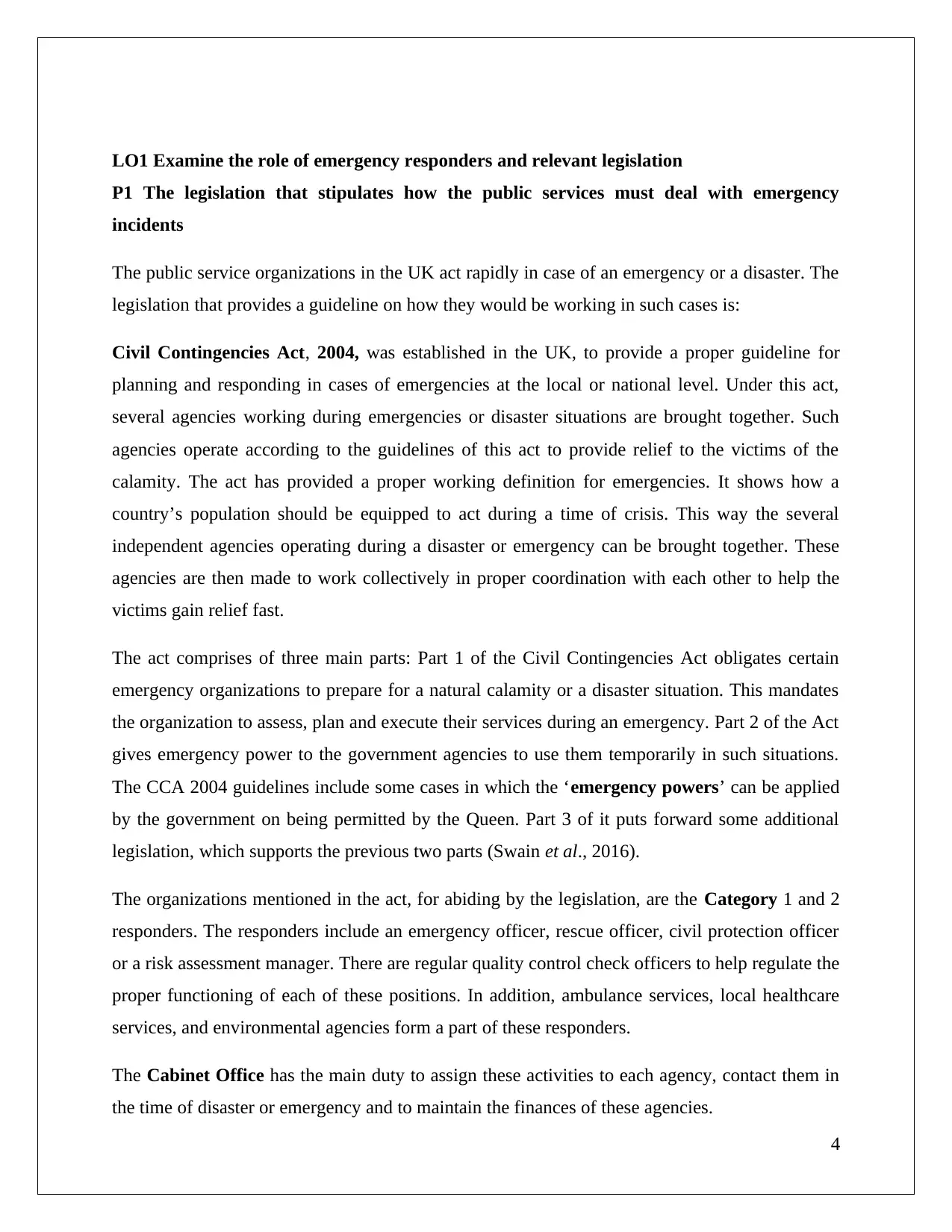
LO1 Examine the role of emergency responders and relevant legislation
P1 The legislation that stipulates how the public services must deal with emergency
incidents
The public service organizations in the UK act rapidly in case of an emergency or a disaster. The
legislation that provides a guideline on how they would be working in such cases is:
Civil Contingencies Act, 2004, was established in the UK, to provide a proper guideline for
planning and responding in cases of emergencies at the local or national level. Under this act,
several agencies working during emergencies or disaster situations are brought together. Such
agencies operate according to the guidelines of this act to provide relief to the victims of the
calamity. The act has provided a proper working definition for emergencies. It shows how a
country’s population should be equipped to act during a time of crisis. This way the several
independent agencies operating during a disaster or emergency can be brought together. These
agencies are then made to work collectively in proper coordination with each other to help the
victims gain relief fast.
The act comprises of three main parts: Part 1 of the Civil Contingencies Act obligates certain
emergency organizations to prepare for a natural calamity or a disaster situation. This mandates
the organization to assess, plan and execute their services during an emergency. Part 2 of the Act
gives emergency power to the government agencies to use them temporarily in such situations.
The CCA 2004 guidelines include some cases in which the ‘emergency powers’ can be applied
by the government on being permitted by the Queen. Part 3 of it puts forward some additional
legislation, which supports the previous two parts (Swain et al., 2016).
The organizations mentioned in the act, for abiding by the legislation, are the Category 1 and 2
responders. The responders include an emergency officer, rescue officer, civil protection officer
or a risk assessment manager. There are regular quality control check officers to help regulate the
proper functioning of each of these positions. In addition, ambulance services, local healthcare
services, and environmental agencies form a part of these responders.
The Cabinet Office has the main duty to assign these activities to each agency, contact them in
the time of disaster or emergency and to maintain the finances of these agencies.
4
P1 The legislation that stipulates how the public services must deal with emergency
incidents
The public service organizations in the UK act rapidly in case of an emergency or a disaster. The
legislation that provides a guideline on how they would be working in such cases is:
Civil Contingencies Act, 2004, was established in the UK, to provide a proper guideline for
planning and responding in cases of emergencies at the local or national level. Under this act,
several agencies working during emergencies or disaster situations are brought together. Such
agencies operate according to the guidelines of this act to provide relief to the victims of the
calamity. The act has provided a proper working definition for emergencies. It shows how a
country’s population should be equipped to act during a time of crisis. This way the several
independent agencies operating during a disaster or emergency can be brought together. These
agencies are then made to work collectively in proper coordination with each other to help the
victims gain relief fast.
The act comprises of three main parts: Part 1 of the Civil Contingencies Act obligates certain
emergency organizations to prepare for a natural calamity or a disaster situation. This mandates
the organization to assess, plan and execute their services during an emergency. Part 2 of the Act
gives emergency power to the government agencies to use them temporarily in such situations.
The CCA 2004 guidelines include some cases in which the ‘emergency powers’ can be applied
by the government on being permitted by the Queen. Part 3 of it puts forward some additional
legislation, which supports the previous two parts (Swain et al., 2016).
The organizations mentioned in the act, for abiding by the legislation, are the Category 1 and 2
responders. The responders include an emergency officer, rescue officer, civil protection officer
or a risk assessment manager. There are regular quality control check officers to help regulate the
proper functioning of each of these positions. In addition, ambulance services, local healthcare
services, and environmental agencies form a part of these responders.
The Cabinet Office has the main duty to assign these activities to each agency, contact them in
the time of disaster or emergency and to maintain the finances of these agencies.
4
Secure Best Marks with AI Grader
Need help grading? Try our AI Grader for instant feedback on your assignments.
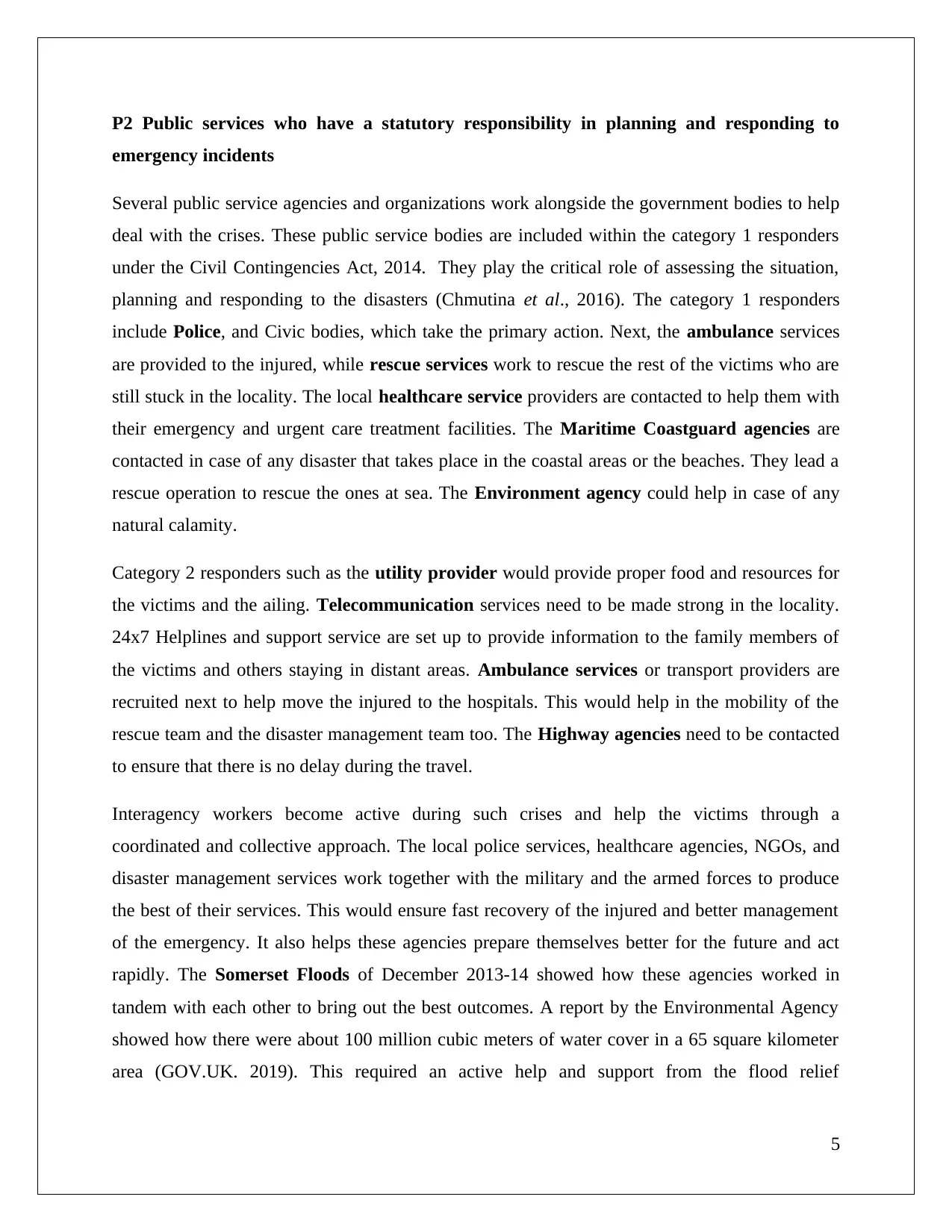
P2 Public services who have a statutory responsibility in planning and responding to
emergency incidents
Several public service agencies and organizations work alongside the government bodies to help
deal with the crises. These public service bodies are included within the category 1 responders
under the Civil Contingencies Act, 2014. They play the critical role of assessing the situation,
planning and responding to the disasters (Chmutina et al., 2016). The category 1 responders
include Police, and Civic bodies, which take the primary action. Next, the ambulance services
are provided to the injured, while rescue services work to rescue the rest of the victims who are
still stuck in the locality. The local healthcare service providers are contacted to help them with
their emergency and urgent care treatment facilities. The Maritime Coastguard agencies are
contacted in case of any disaster that takes place in the coastal areas or the beaches. They lead a
rescue operation to rescue the ones at sea. The Environment agency could help in case of any
natural calamity.
Category 2 responders such as the utility provider would provide proper food and resources for
the victims and the ailing. Telecommunication services need to be made strong in the locality.
24x7 Helplines and support service are set up to provide information to the family members of
the victims and others staying in distant areas. Ambulance services or transport providers are
recruited next to help move the injured to the hospitals. This would help in the mobility of the
rescue team and the disaster management team too. The Highway agencies need to be contacted
to ensure that there is no delay during the travel.
Interagency workers become active during such crises and help the victims through a
coordinated and collective approach. The local police services, healthcare agencies, NGOs, and
disaster management services work together with the military and the armed forces to produce
the best of their services. This would ensure fast recovery of the injured and better management
of the emergency. It also helps these agencies prepare themselves better for the future and act
rapidly. The Somerset Floods of December 2013-14 showed how these agencies worked in
tandem with each other to bring out the best outcomes. A report by the Environmental Agency
showed how there were about 100 million cubic meters of water cover in a 65 square kilometer
area (GOV.UK. 2019). This required an active help and support from the flood relief
5
emergency incidents
Several public service agencies and organizations work alongside the government bodies to help
deal with the crises. These public service bodies are included within the category 1 responders
under the Civil Contingencies Act, 2014. They play the critical role of assessing the situation,
planning and responding to the disasters (Chmutina et al., 2016). The category 1 responders
include Police, and Civic bodies, which take the primary action. Next, the ambulance services
are provided to the injured, while rescue services work to rescue the rest of the victims who are
still stuck in the locality. The local healthcare service providers are contacted to help them with
their emergency and urgent care treatment facilities. The Maritime Coastguard agencies are
contacted in case of any disaster that takes place in the coastal areas or the beaches. They lead a
rescue operation to rescue the ones at sea. The Environment agency could help in case of any
natural calamity.
Category 2 responders such as the utility provider would provide proper food and resources for
the victims and the ailing. Telecommunication services need to be made strong in the locality.
24x7 Helplines and support service are set up to provide information to the family members of
the victims and others staying in distant areas. Ambulance services or transport providers are
recruited next to help move the injured to the hospitals. This would help in the mobility of the
rescue team and the disaster management team too. The Highway agencies need to be contacted
to ensure that there is no delay during the travel.
Interagency workers become active during such crises and help the victims through a
coordinated and collective approach. The local police services, healthcare agencies, NGOs, and
disaster management services work together with the military and the armed forces to produce
the best of their services. This would ensure fast recovery of the injured and better management
of the emergency. It also helps these agencies prepare themselves better for the future and act
rapidly. The Somerset Floods of December 2013-14 showed how these agencies worked in
tandem with each other to bring out the best outcomes. A report by the Environmental Agency
showed how there were about 100 million cubic meters of water cover in a 65 square kilometer
area (GOV.UK. 2019). This required an active help and support from the flood relief
5
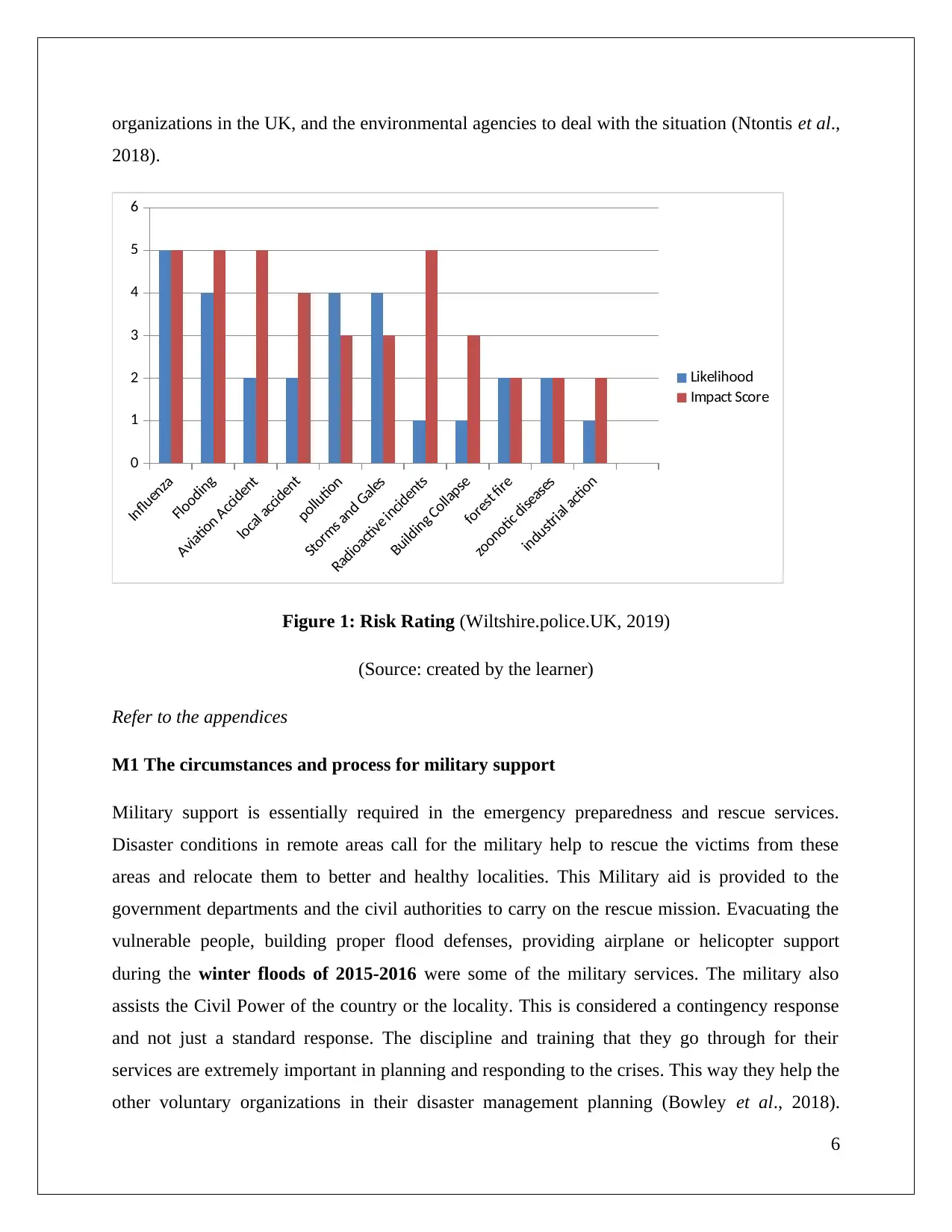
organizations in the UK, and the environmental agencies to deal with the situation (Ntontis et al.,
2018).
Influenza
Flooding
Aviation Accident
local accident
pollution
Storms and Gales
Radioactive incidents
Building Collapse
forest fire
zoonotic diseases
industrial action
0
1
2
3
4
5
6
Likelihood
Impact Score
Figure 1: Risk Rating (Wiltshire.police.UK, 2019)
(Source: created by the learner)
Refer to the appendices
M1 The circumstances and process for military support
Military support is essentially required in the emergency preparedness and rescue services.
Disaster conditions in remote areas call for the military help to rescue the victims from these
areas and relocate them to better and healthy localities. This Military aid is provided to the
government departments and the civil authorities to carry on the rescue mission. Evacuating the
vulnerable people, building proper flood defenses, providing airplane or helicopter support
during the winter floods of 2015-2016 were some of the military services. The military also
assists the Civil Power of the country or the locality. This is considered a contingency response
and not just a standard response. The discipline and training that they go through for their
services are extremely important in planning and responding to the crises. This way they help the
other voluntary organizations in their disaster management planning (Bowley et al., 2018).
6
2018).
Influenza
Flooding
Aviation Accident
local accident
pollution
Storms and Gales
Radioactive incidents
Building Collapse
forest fire
zoonotic diseases
industrial action
0
1
2
3
4
5
6
Likelihood
Impact Score
Figure 1: Risk Rating (Wiltshire.police.UK, 2019)
(Source: created by the learner)
Refer to the appendices
M1 The circumstances and process for military support
Military support is essentially required in the emergency preparedness and rescue services.
Disaster conditions in remote areas call for the military help to rescue the victims from these
areas and relocate them to better and healthy localities. This Military aid is provided to the
government departments and the civil authorities to carry on the rescue mission. Evacuating the
vulnerable people, building proper flood defenses, providing airplane or helicopter support
during the winter floods of 2015-2016 were some of the military services. The military also
assists the Civil Power of the country or the locality. This is considered a contingency response
and not just a standard response. The discipline and training that they go through for their
services are extremely important in planning and responding to the crises. This way they help the
other voluntary organizations in their disaster management planning (Bowley et al., 2018).
6
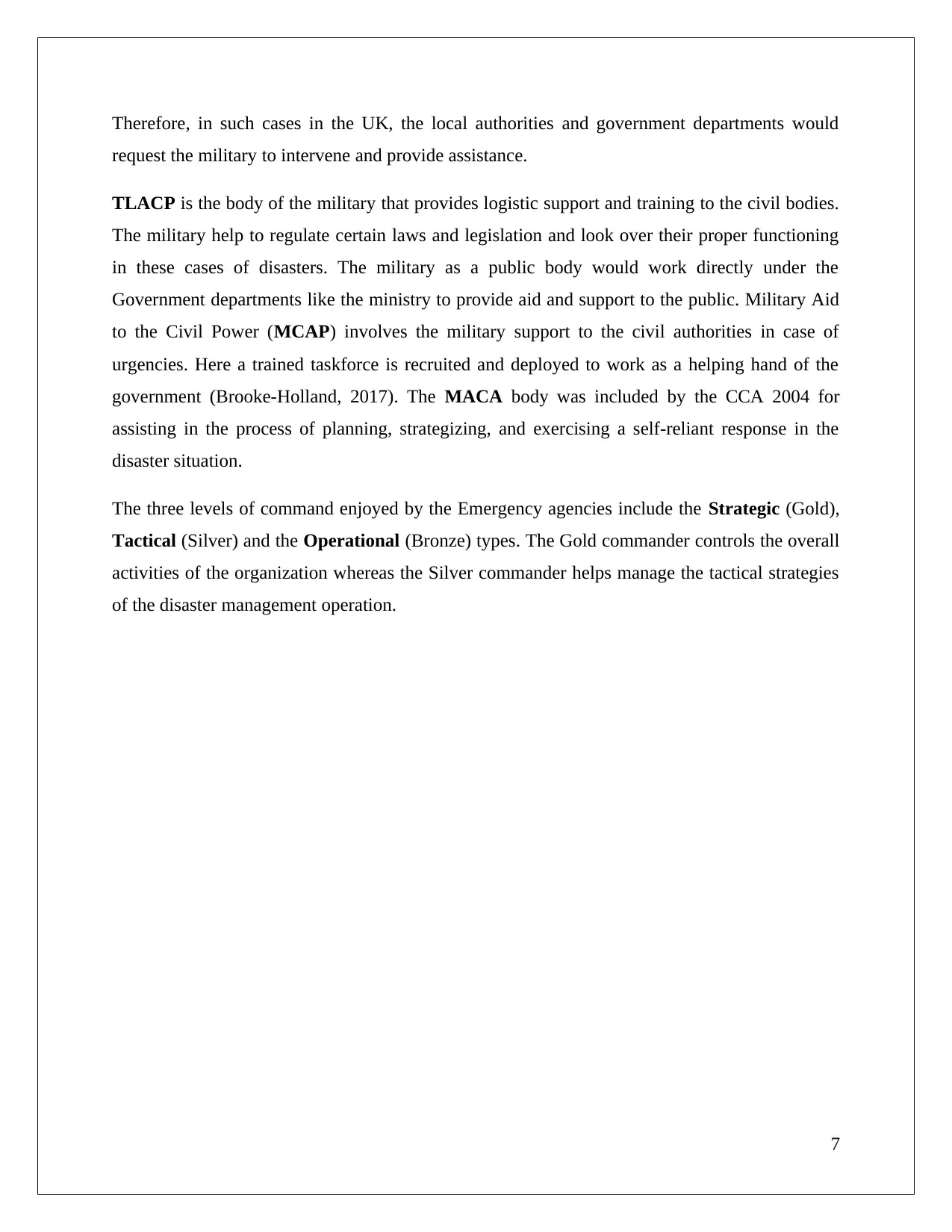
Therefore, in such cases in the UK, the local authorities and government departments would
request the military to intervene and provide assistance.
TLACP is the body of the military that provides logistic support and training to the civil bodies.
The military help to regulate certain laws and legislation and look over their proper functioning
in these cases of disasters. The military as a public body would work directly under the
Government departments like the ministry to provide aid and support to the public. Military Aid
to the Civil Power (MCAP) involves the military support to the civil authorities in case of
urgencies. Here a trained taskforce is recruited and deployed to work as a helping hand of the
government (Brooke-Holland, 2017). The MACA body was included by the CCA 2004 for
assisting in the process of planning, strategizing, and exercising a self-reliant response in the
disaster situation.
The three levels of command enjoyed by the Emergency agencies include the Strategic (Gold),
Tactical (Silver) and the Operational (Bronze) types. The Gold commander controls the overall
activities of the organization whereas the Silver commander helps manage the tactical strategies
of the disaster management operation.
7
request the military to intervene and provide assistance.
TLACP is the body of the military that provides logistic support and training to the civil bodies.
The military help to regulate certain laws and legislation and look over their proper functioning
in these cases of disasters. The military as a public body would work directly under the
Government departments like the ministry to provide aid and support to the public. Military Aid
to the Civil Power (MCAP) involves the military support to the civil authorities in case of
urgencies. Here a trained taskforce is recruited and deployed to work as a helping hand of the
government (Brooke-Holland, 2017). The MACA body was included by the CCA 2004 for
assisting in the process of planning, strategizing, and exercising a self-reliant response in the
disaster situation.
The three levels of command enjoyed by the Emergency agencies include the Strategic (Gold),
Tactical (Silver) and the Operational (Bronze) types. The Gold commander controls the overall
activities of the organization whereas the Silver commander helps manage the tactical strategies
of the disaster management operation.
7
Paraphrase This Document
Need a fresh take? Get an instant paraphrase of this document with our AI Paraphraser
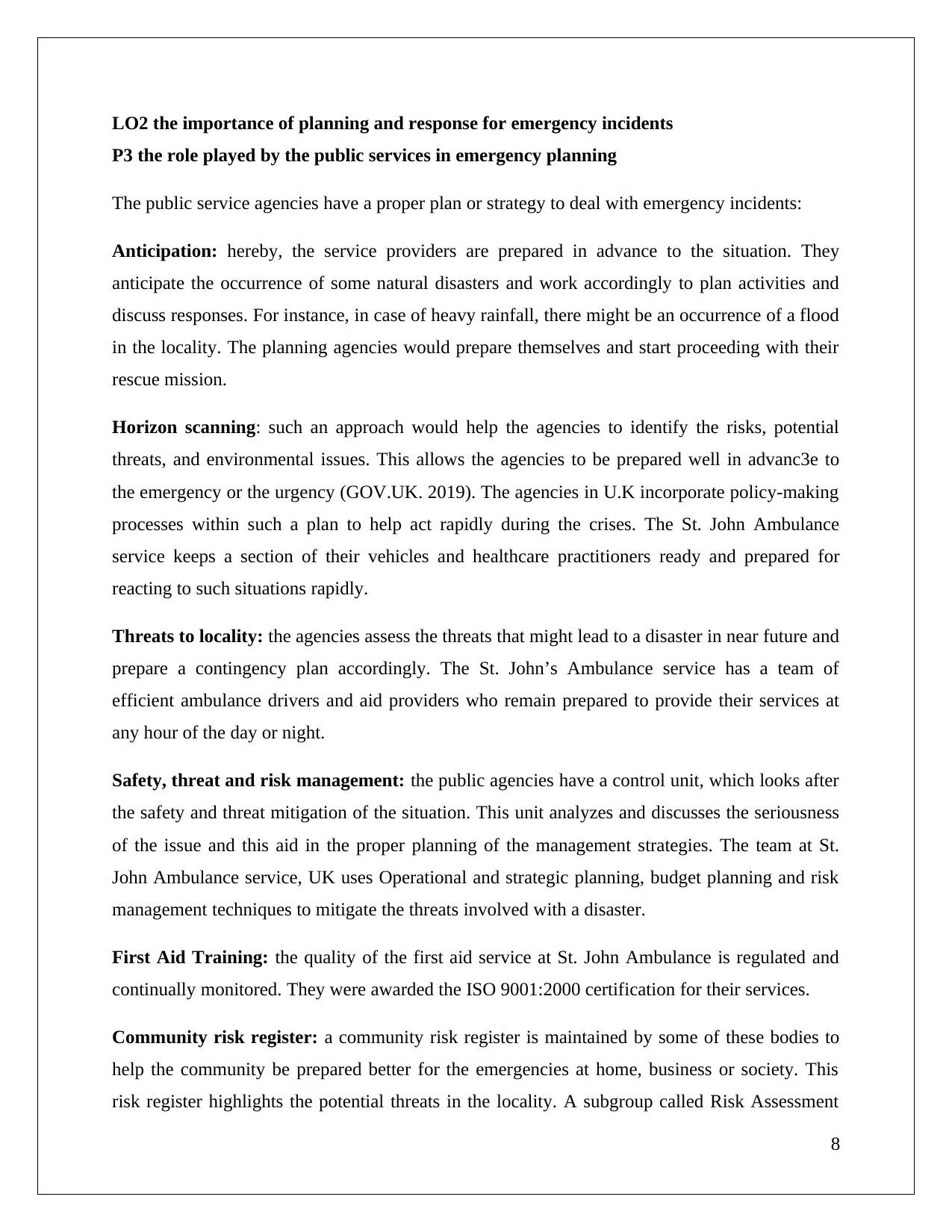
LO2 the importance of planning and response for emergency incidents
P3 the role played by the public services in emergency planning
The public service agencies have a proper plan or strategy to deal with emergency incidents:
Anticipation: hereby, the service providers are prepared in advance to the situation. They
anticipate the occurrence of some natural disasters and work accordingly to plan activities and
discuss responses. For instance, in case of heavy rainfall, there might be an occurrence of a flood
in the locality. The planning agencies would prepare themselves and start proceeding with their
rescue mission.
Horizon scanning: such an approach would help the agencies to identify the risks, potential
threats, and environmental issues. This allows the agencies to be prepared well in advanc3e to
the emergency or the urgency (GOV.UK. 2019). The agencies in U.K incorporate policy-making
processes within such a plan to help act rapidly during the crises. The St. John Ambulance
service keeps a section of their vehicles and healthcare practitioners ready and prepared for
reacting to such situations rapidly.
Threats to locality: the agencies assess the threats that might lead to a disaster in near future and
prepare a contingency plan accordingly. The St. John’s Ambulance service has a team of
efficient ambulance drivers and aid providers who remain prepared to provide their services at
any hour of the day or night.
Safety, threat and risk management: the public agencies have a control unit, which looks after
the safety and threat mitigation of the situation. This unit analyzes and discusses the seriousness
of the issue and this aid in the proper planning of the management strategies. The team at St.
John Ambulance service, UK uses Operational and strategic planning, budget planning and risk
management techniques to mitigate the threats involved with a disaster.
First Aid Training: the quality of the first aid service at St. John Ambulance is regulated and
continually monitored. They were awarded the ISO 9001:2000 certification for their services.
Community risk register: a community risk register is maintained by some of these bodies to
help the community be prepared better for the emergencies at home, business or society. This
risk register highlights the potential threats in the locality. A subgroup called Risk Assessment
8
P3 the role played by the public services in emergency planning
The public service agencies have a proper plan or strategy to deal with emergency incidents:
Anticipation: hereby, the service providers are prepared in advance to the situation. They
anticipate the occurrence of some natural disasters and work accordingly to plan activities and
discuss responses. For instance, in case of heavy rainfall, there might be an occurrence of a flood
in the locality. The planning agencies would prepare themselves and start proceeding with their
rescue mission.
Horizon scanning: such an approach would help the agencies to identify the risks, potential
threats, and environmental issues. This allows the agencies to be prepared well in advanc3e to
the emergency or the urgency (GOV.UK. 2019). The agencies in U.K incorporate policy-making
processes within such a plan to help act rapidly during the crises. The St. John Ambulance
service keeps a section of their vehicles and healthcare practitioners ready and prepared for
reacting to such situations rapidly.
Threats to locality: the agencies assess the threats that might lead to a disaster in near future and
prepare a contingency plan accordingly. The St. John’s Ambulance service has a team of
efficient ambulance drivers and aid providers who remain prepared to provide their services at
any hour of the day or night.
Safety, threat and risk management: the public agencies have a control unit, which looks after
the safety and threat mitigation of the situation. This unit analyzes and discusses the seriousness
of the issue and this aid in the proper planning of the management strategies. The team at St.
John Ambulance service, UK uses Operational and strategic planning, budget planning and risk
management techniques to mitigate the threats involved with a disaster.
First Aid Training: the quality of the first aid service at St. John Ambulance is regulated and
continually monitored. They were awarded the ISO 9001:2000 certification for their services.
Community risk register: a community risk register is maintained by some of these bodies to
help the community be prepared better for the emergencies at home, business or society. This
risk register highlights the potential threats in the locality. A subgroup called Risk Assessment
8
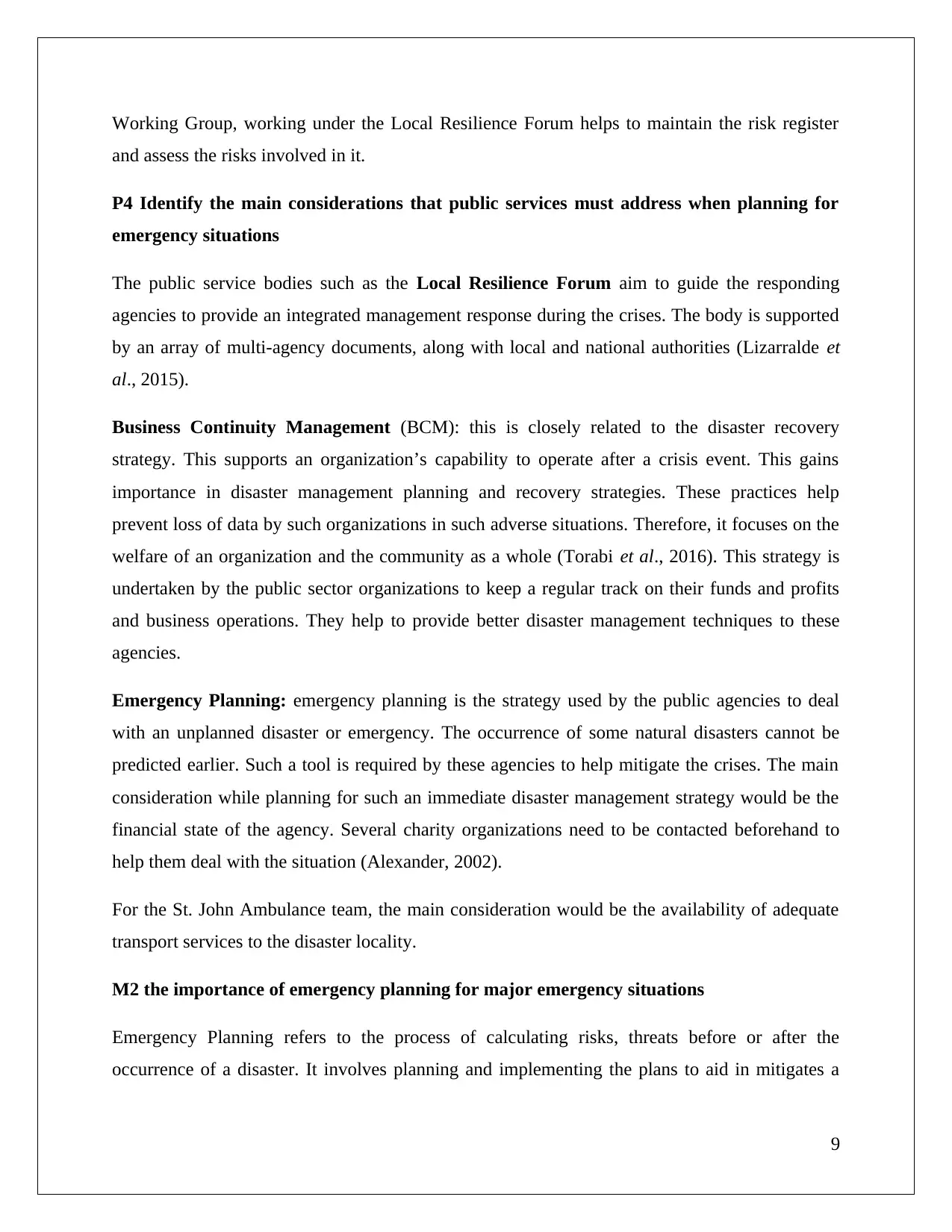
Working Group, working under the Local Resilience Forum helps to maintain the risk register
and assess the risks involved in it.
P4 Identify the main considerations that public services must address when planning for
emergency situations
The public service bodies such as the Local Resilience Forum aim to guide the responding
agencies to provide an integrated management response during the crises. The body is supported
by an array of multi-agency documents, along with local and national authorities (Lizarralde et
al., 2015).
Business Continuity Management (BCM): this is closely related to the disaster recovery
strategy. This supports an organization’s capability to operate after a crisis event. This gains
importance in disaster management planning and recovery strategies. These practices help
prevent loss of data by such organizations in such adverse situations. Therefore, it focuses on the
welfare of an organization and the community as a whole (Torabi et al., 2016). This strategy is
undertaken by the public sector organizations to keep a regular track on their funds and profits
and business operations. They help to provide better disaster management techniques to these
agencies.
Emergency Planning: emergency planning is the strategy used by the public agencies to deal
with an unplanned disaster or emergency. The occurrence of some natural disasters cannot be
predicted earlier. Such a tool is required by these agencies to help mitigate the crises. The main
consideration while planning for such an immediate disaster management strategy would be the
financial state of the agency. Several charity organizations need to be contacted beforehand to
help them deal with the situation (Alexander, 2002).
For the St. John Ambulance team, the main consideration would be the availability of adequate
transport services to the disaster locality.
M2 the importance of emergency planning for major emergency situations
Emergency Planning refers to the process of calculating risks, threats before or after the
occurrence of a disaster. It involves planning and implementing the plans to aid in mitigates a
9
and assess the risks involved in it.
P4 Identify the main considerations that public services must address when planning for
emergency situations
The public service bodies such as the Local Resilience Forum aim to guide the responding
agencies to provide an integrated management response during the crises. The body is supported
by an array of multi-agency documents, along with local and national authorities (Lizarralde et
al., 2015).
Business Continuity Management (BCM): this is closely related to the disaster recovery
strategy. This supports an organization’s capability to operate after a crisis event. This gains
importance in disaster management planning and recovery strategies. These practices help
prevent loss of data by such organizations in such adverse situations. Therefore, it focuses on the
welfare of an organization and the community as a whole (Torabi et al., 2016). This strategy is
undertaken by the public sector organizations to keep a regular track on their funds and profits
and business operations. They help to provide better disaster management techniques to these
agencies.
Emergency Planning: emergency planning is the strategy used by the public agencies to deal
with an unplanned disaster or emergency. The occurrence of some natural disasters cannot be
predicted earlier. Such a tool is required by these agencies to help mitigate the crises. The main
consideration while planning for such an immediate disaster management strategy would be the
financial state of the agency. Several charity organizations need to be contacted beforehand to
help them deal with the situation (Alexander, 2002).
For the St. John Ambulance team, the main consideration would be the availability of adequate
transport services to the disaster locality.
M2 the importance of emergency planning for major emergency situations
Emergency Planning refers to the process of calculating risks, threats before or after the
occurrence of a disaster. It involves planning and implementing the plans to aid in mitigates a
9
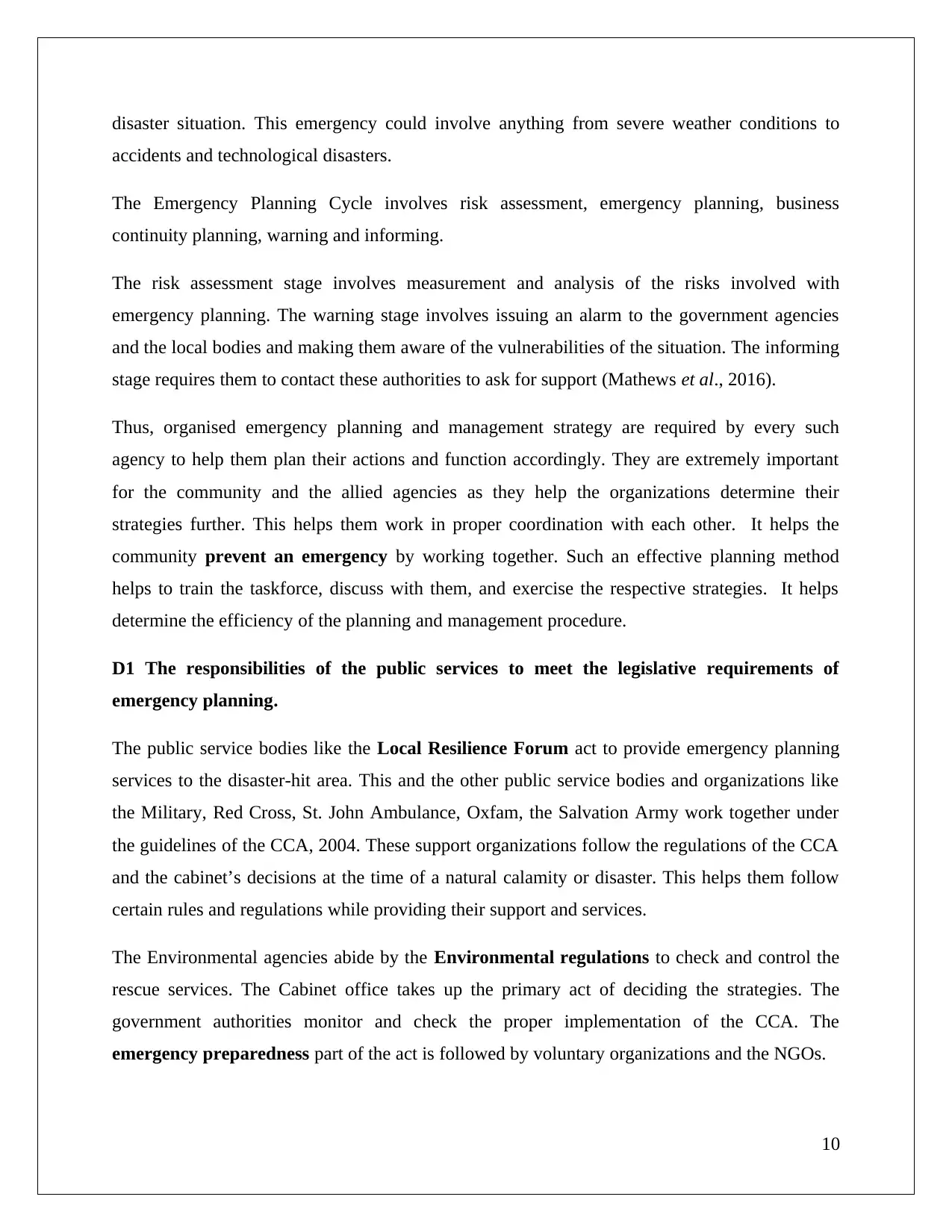
disaster situation. This emergency could involve anything from severe weather conditions to
accidents and technological disasters.
The Emergency Planning Cycle involves risk assessment, emergency planning, business
continuity planning, warning and informing.
The risk assessment stage involves measurement and analysis of the risks involved with
emergency planning. The warning stage involves issuing an alarm to the government agencies
and the local bodies and making them aware of the vulnerabilities of the situation. The informing
stage requires them to contact these authorities to ask for support (Mathews et al., 2016).
Thus, organised emergency planning and management strategy are required by every such
agency to help them plan their actions and function accordingly. They are extremely important
for the community and the allied agencies as they help the organizations determine their
strategies further. This helps them work in proper coordination with each other. It helps the
community prevent an emergency by working together. Such an effective planning method
helps to train the taskforce, discuss with them, and exercise the respective strategies. It helps
determine the efficiency of the planning and management procedure.
D1 The responsibilities of the public services to meet the legislative requirements of
emergency planning.
The public service bodies like the Local Resilience Forum act to provide emergency planning
services to the disaster-hit area. This and the other public service bodies and organizations like
the Military, Red Cross, St. John Ambulance, Oxfam, the Salvation Army work together under
the guidelines of the CCA, 2004. These support organizations follow the regulations of the CCA
and the cabinet’s decisions at the time of a natural calamity or disaster. This helps them follow
certain rules and regulations while providing their support and services.
The Environmental agencies abide by the Environmental regulations to check and control the
rescue services. The Cabinet office takes up the primary act of deciding the strategies. The
government authorities monitor and check the proper implementation of the CCA. The
emergency preparedness part of the act is followed by voluntary organizations and the NGOs.
10
accidents and technological disasters.
The Emergency Planning Cycle involves risk assessment, emergency planning, business
continuity planning, warning and informing.
The risk assessment stage involves measurement and analysis of the risks involved with
emergency planning. The warning stage involves issuing an alarm to the government agencies
and the local bodies and making them aware of the vulnerabilities of the situation. The informing
stage requires them to contact these authorities to ask for support (Mathews et al., 2016).
Thus, organised emergency planning and management strategy are required by every such
agency to help them plan their actions and function accordingly. They are extremely important
for the community and the allied agencies as they help the organizations determine their
strategies further. This helps them work in proper coordination with each other. It helps the
community prevent an emergency by working together. Such an effective planning method
helps to train the taskforce, discuss with them, and exercise the respective strategies. It helps
determine the efficiency of the planning and management procedure.
D1 The responsibilities of the public services to meet the legislative requirements of
emergency planning.
The public service bodies like the Local Resilience Forum act to provide emergency planning
services to the disaster-hit area. This and the other public service bodies and organizations like
the Military, Red Cross, St. John Ambulance, Oxfam, the Salvation Army work together under
the guidelines of the CCA, 2004. These support organizations follow the regulations of the CCA
and the cabinet’s decisions at the time of a natural calamity or disaster. This helps them follow
certain rules and regulations while providing their support and services.
The Environmental agencies abide by the Environmental regulations to check and control the
rescue services. The Cabinet office takes up the primary act of deciding the strategies. The
government authorities monitor and check the proper implementation of the CCA. The
emergency preparedness part of the act is followed by voluntary organizations and the NGOs.
10
Secure Best Marks with AI Grader
Need help grading? Try our AI Grader for instant feedback on your assignments.
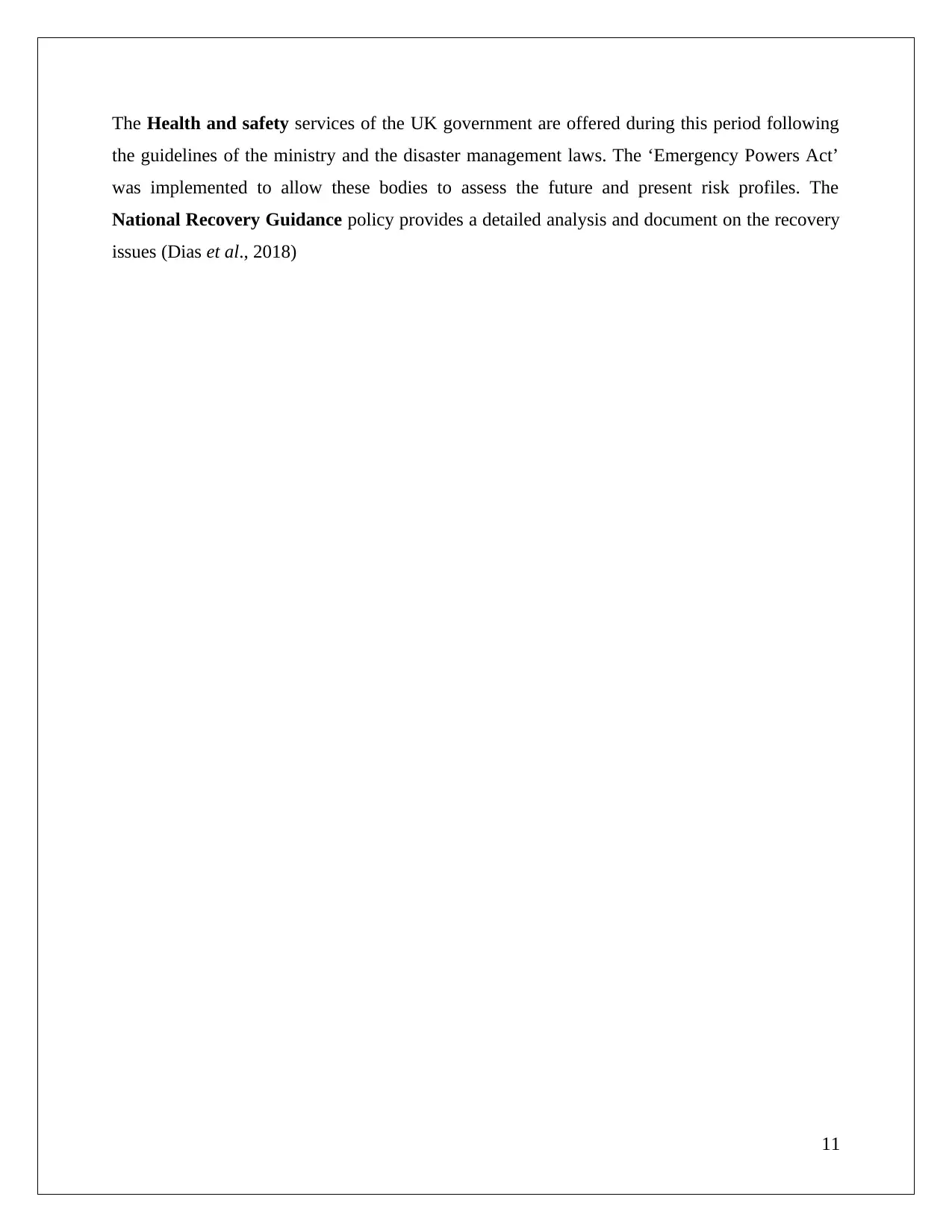
The Health and safety services of the UK government are offered during this period following
the guidelines of the ministry and the disaster management laws. The ‘Emergency Powers Act’
was implemented to allow these bodies to assess the future and present risk profiles. The
National Recovery Guidance policy provides a detailed analysis and document on the recovery
issues (Dias et al., 2018)
11
the guidelines of the ministry and the disaster management laws. The ‘Emergency Powers Act’
was implemented to allow these bodies to assess the future and present risk profiles. The
National Recovery Guidance policy provides a detailed analysis and document on the recovery
issues (Dias et al., 2018)
11
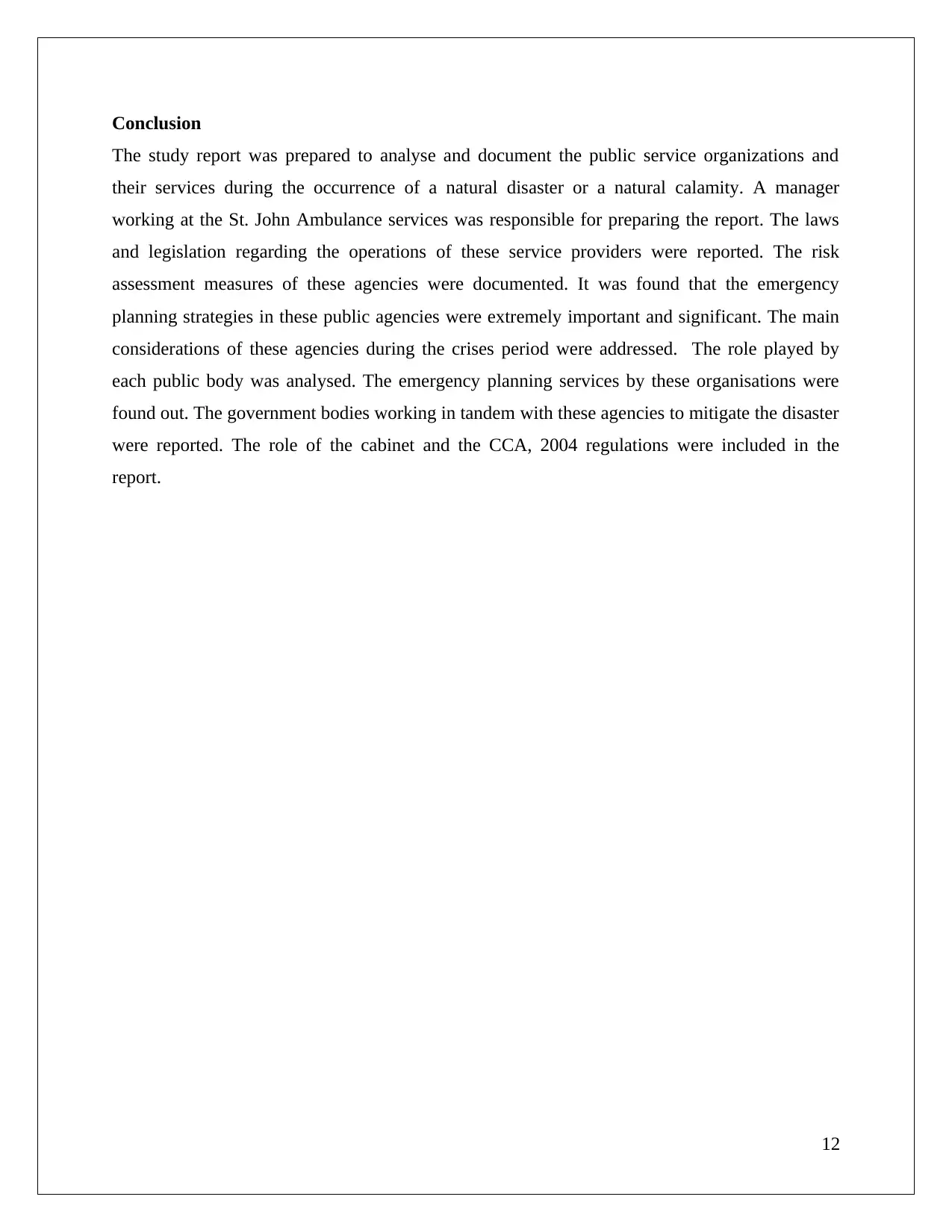
Conclusion
The study report was prepared to analyse and document the public service organizations and
their services during the occurrence of a natural disaster or a natural calamity. A manager
working at the St. John Ambulance services was responsible for preparing the report. The laws
and legislation regarding the operations of these service providers were reported. The risk
assessment measures of these agencies were documented. It was found that the emergency
planning strategies in these public agencies were extremely important and significant. The main
considerations of these agencies during the crises period were addressed. The role played by
each public body was analysed. The emergency planning services by these organisations were
found out. The government bodies working in tandem with these agencies to mitigate the disaster
were reported. The role of the cabinet and the CCA, 2004 regulations were included in the
report.
12
The study report was prepared to analyse and document the public service organizations and
their services during the occurrence of a natural disaster or a natural calamity. A manager
working at the St. John Ambulance services was responsible for preparing the report. The laws
and legislation regarding the operations of these service providers were reported. The risk
assessment measures of these agencies were documented. It was found that the emergency
planning strategies in these public agencies were extremely important and significant. The main
considerations of these agencies during the crises period were addressed. The role played by
each public body was analysed. The emergency planning services by these organisations were
found out. The government bodies working in tandem with these agencies to mitigate the disaster
were reported. The role of the cabinet and the CCA, 2004 regulations were included in the
report.
12
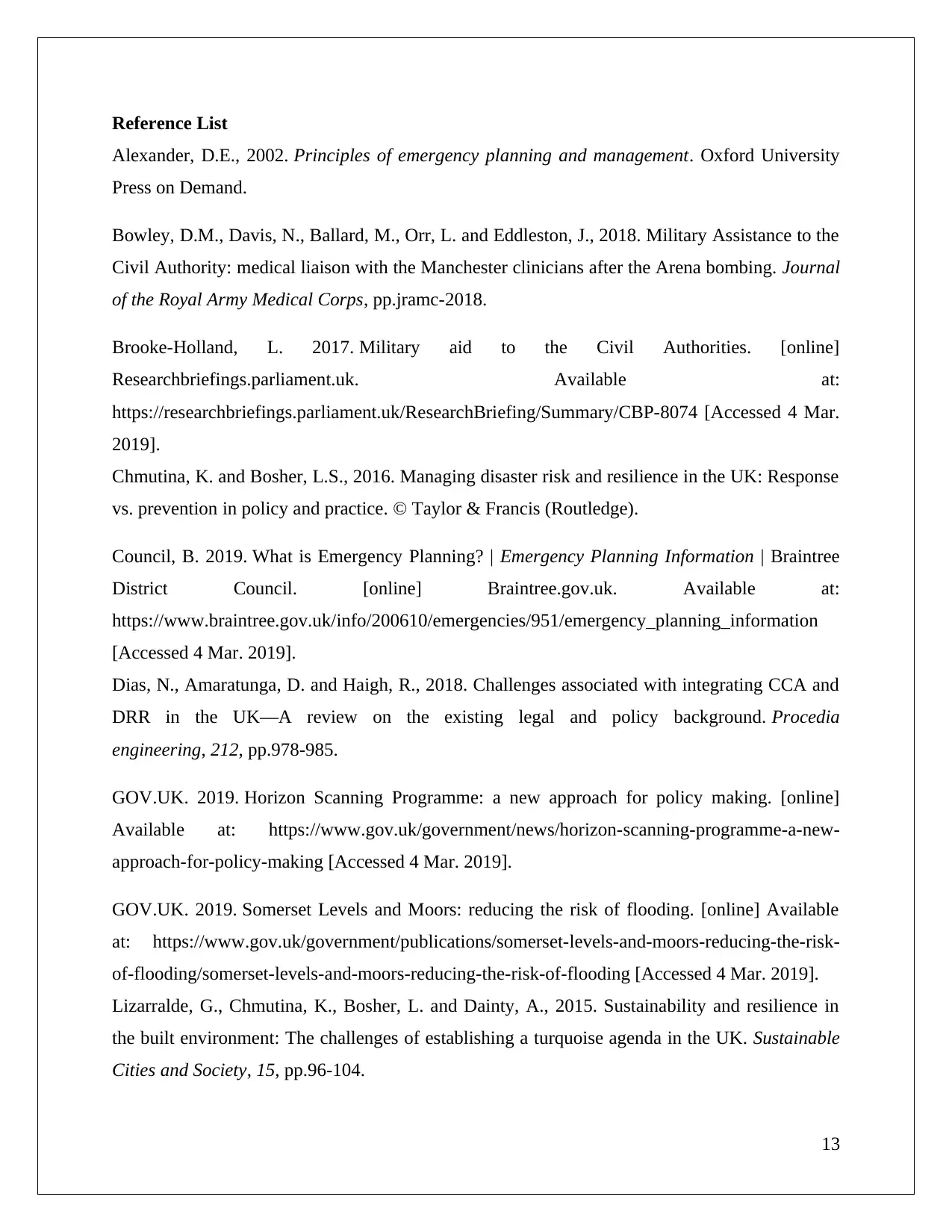
Reference List
Alexander, D.E., 2002. Principles of emergency planning and management. Oxford University
Press on Demand.
Bowley, D.M., Davis, N., Ballard, M., Orr, L. and Eddleston, J., 2018. Military Assistance to the
Civil Authority: medical liaison with the Manchester clinicians after the Arena bombing. Journal
of the Royal Army Medical Corps, pp.jramc-2018.
Brooke-Holland, L. 2017. Military aid to the Civil Authorities. [online]
Researchbriefings.parliament.uk. Available at:
https://researchbriefings.parliament.uk/ResearchBriefing/Summary/CBP-8074 [Accessed 4 Mar.
2019].
Chmutina, K. and Bosher, L.S., 2016. Managing disaster risk and resilience in the UK: Response
vs. prevention in policy and practice. © Taylor & Francis (Routledge).
Council, B. 2019. What is Emergency Planning? | Emergency Planning Information | Braintree
District Council. [online] Braintree.gov.uk. Available at:
https://www.braintree.gov.uk/info/200610/emergencies/951/emergency_planning_information
[Accessed 4 Mar. 2019].
Dias, N., Amaratunga, D. and Haigh, R., 2018. Challenges associated with integrating CCA and
DRR in the UK—A review on the existing legal and policy background. Procedia
engineering, 212, pp.978-985.
GOV.UK. 2019. Horizon Scanning Programme: a new approach for policy making. [online]
Available at: https://www.gov.uk/government/news/horizon-scanning-programme-a-new-
approach-for-policy-making [Accessed 4 Mar. 2019].
GOV.UK. 2019. Somerset Levels and Moors: reducing the risk of flooding. [online] Available
at: https://www.gov.uk/government/publications/somerset-levels-and-moors-reducing-the-risk-
of-flooding/somerset-levels-and-moors-reducing-the-risk-of-flooding [Accessed 4 Mar. 2019].
Lizarralde, G., Chmutina, K., Bosher, L. and Dainty, A., 2015. Sustainability and resilience in
the built environment: The challenges of establishing a turquoise agenda in the UK. Sustainable
Cities and Society, 15, pp.96-104.
13
Alexander, D.E., 2002. Principles of emergency planning and management. Oxford University
Press on Demand.
Bowley, D.M., Davis, N., Ballard, M., Orr, L. and Eddleston, J., 2018. Military Assistance to the
Civil Authority: medical liaison with the Manchester clinicians after the Arena bombing. Journal
of the Royal Army Medical Corps, pp.jramc-2018.
Brooke-Holland, L. 2017. Military aid to the Civil Authorities. [online]
Researchbriefings.parliament.uk. Available at:
https://researchbriefings.parliament.uk/ResearchBriefing/Summary/CBP-8074 [Accessed 4 Mar.
2019].
Chmutina, K. and Bosher, L.S., 2016. Managing disaster risk and resilience in the UK: Response
vs. prevention in policy and practice. © Taylor & Francis (Routledge).
Council, B. 2019. What is Emergency Planning? | Emergency Planning Information | Braintree
District Council. [online] Braintree.gov.uk. Available at:
https://www.braintree.gov.uk/info/200610/emergencies/951/emergency_planning_information
[Accessed 4 Mar. 2019].
Dias, N., Amaratunga, D. and Haigh, R., 2018. Challenges associated with integrating CCA and
DRR in the UK—A review on the existing legal and policy background. Procedia
engineering, 212, pp.978-985.
GOV.UK. 2019. Horizon Scanning Programme: a new approach for policy making. [online]
Available at: https://www.gov.uk/government/news/horizon-scanning-programme-a-new-
approach-for-policy-making [Accessed 4 Mar. 2019].
GOV.UK. 2019. Somerset Levels and Moors: reducing the risk of flooding. [online] Available
at: https://www.gov.uk/government/publications/somerset-levels-and-moors-reducing-the-risk-
of-flooding/somerset-levels-and-moors-reducing-the-risk-of-flooding [Accessed 4 Mar. 2019].
Lizarralde, G., Chmutina, K., Bosher, L. and Dainty, A., 2015. Sustainability and resilience in
the built environment: The challenges of establishing a turquoise agenda in the UK. Sustainable
Cities and Society, 15, pp.96-104.
13
Paraphrase This Document
Need a fresh take? Get an instant paraphrase of this document with our AI Paraphraser
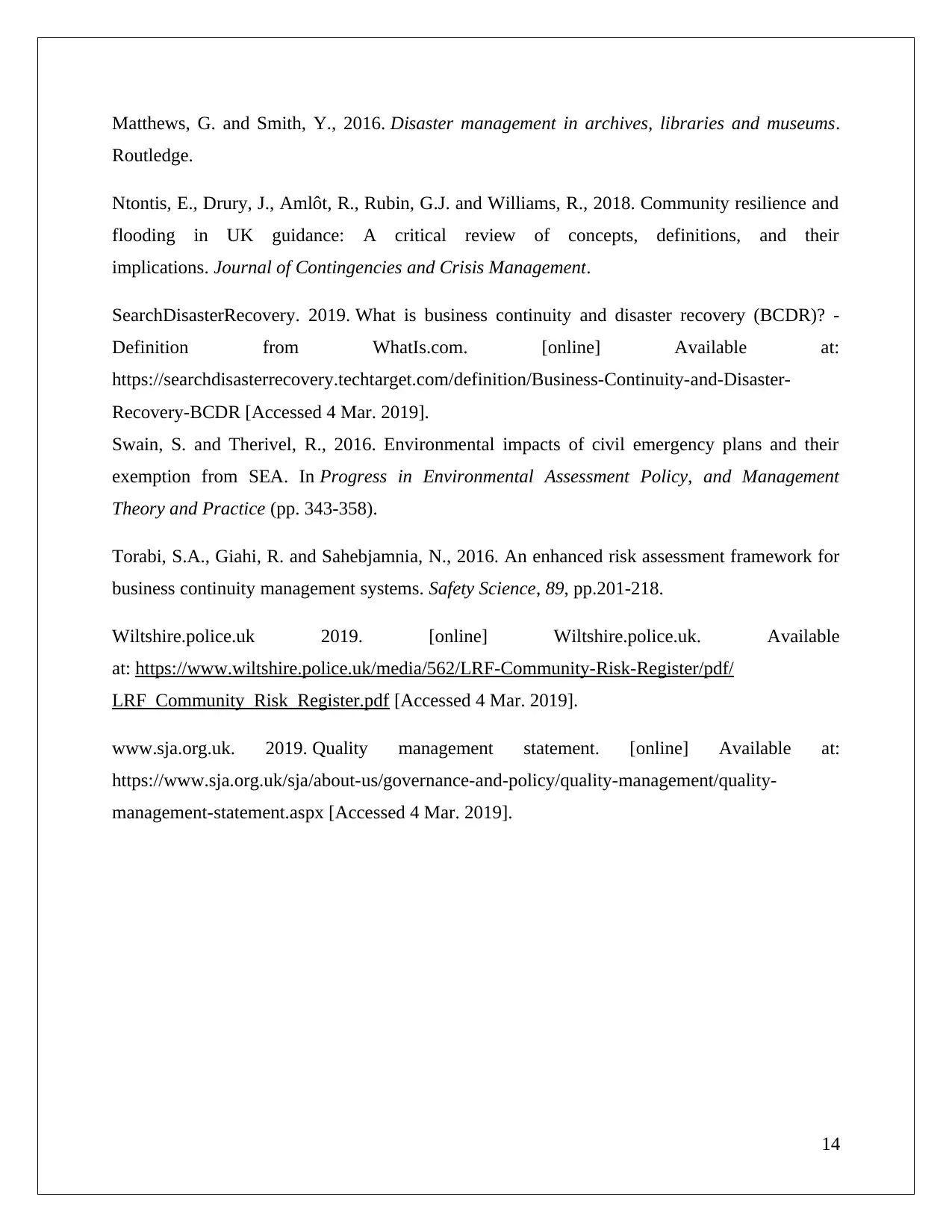
Matthews, G. and Smith, Y., 2016. Disaster management in archives, libraries and museums.
Routledge.
Ntontis, E., Drury, J., Amlôt, R., Rubin, G.J. and Williams, R., 2018. Community resilience and
flooding in UK guidance: A critical review of concepts, definitions, and their
implications. Journal of Contingencies and Crisis Management.
SearchDisasterRecovery. 2019. What is business continuity and disaster recovery (BCDR)? -
Definition from WhatIs.com. [online] Available at:
https://searchdisasterrecovery.techtarget.com/definition/Business-Continuity-and-Disaster-
Recovery-BCDR [Accessed 4 Mar. 2019].
Swain, S. and Therivel, R., 2016. Environmental impacts of civil emergency plans and their
exemption from SEA. In Progress in Environmental Assessment Policy, and Management
Theory and Practice (pp. 343-358).
Torabi, S.A., Giahi, R. and Sahebjamnia, N., 2016. An enhanced risk assessment framework for
business continuity management systems. Safety Science, 89, pp.201-218.
Wiltshire.police.uk 2019. [online] Wiltshire.police.uk. Available
at: https://www.wiltshire.police.uk/media/562/LRF-Community-Risk-Register/pdf/
LRF_Community_Risk_Register.pdf [Accessed 4 Mar. 2019].
www.sja.org.uk. 2019. Quality management statement. [online] Available at:
https://www.sja.org.uk/sja/about-us/governance-and-policy/quality-management/quality-
management-statement.aspx [Accessed 4 Mar. 2019].
14
Routledge.
Ntontis, E., Drury, J., Amlôt, R., Rubin, G.J. and Williams, R., 2018. Community resilience and
flooding in UK guidance: A critical review of concepts, definitions, and their
implications. Journal of Contingencies and Crisis Management.
SearchDisasterRecovery. 2019. What is business continuity and disaster recovery (BCDR)? -
Definition from WhatIs.com. [online] Available at:
https://searchdisasterrecovery.techtarget.com/definition/Business-Continuity-and-Disaster-
Recovery-BCDR [Accessed 4 Mar. 2019].
Swain, S. and Therivel, R., 2016. Environmental impacts of civil emergency plans and their
exemption from SEA. In Progress in Environmental Assessment Policy, and Management
Theory and Practice (pp. 343-358).
Torabi, S.A., Giahi, R. and Sahebjamnia, N., 2016. An enhanced risk assessment framework for
business continuity management systems. Safety Science, 89, pp.201-218.
Wiltshire.police.uk 2019. [online] Wiltshire.police.uk. Available
at: https://www.wiltshire.police.uk/media/562/LRF-Community-Risk-Register/pdf/
LRF_Community_Risk_Register.pdf [Accessed 4 Mar. 2019].
www.sja.org.uk. 2019. Quality management statement. [online] Available at:
https://www.sja.org.uk/sja/about-us/governance-and-policy/quality-management/quality-
management-statement.aspx [Accessed 4 Mar. 2019].
14
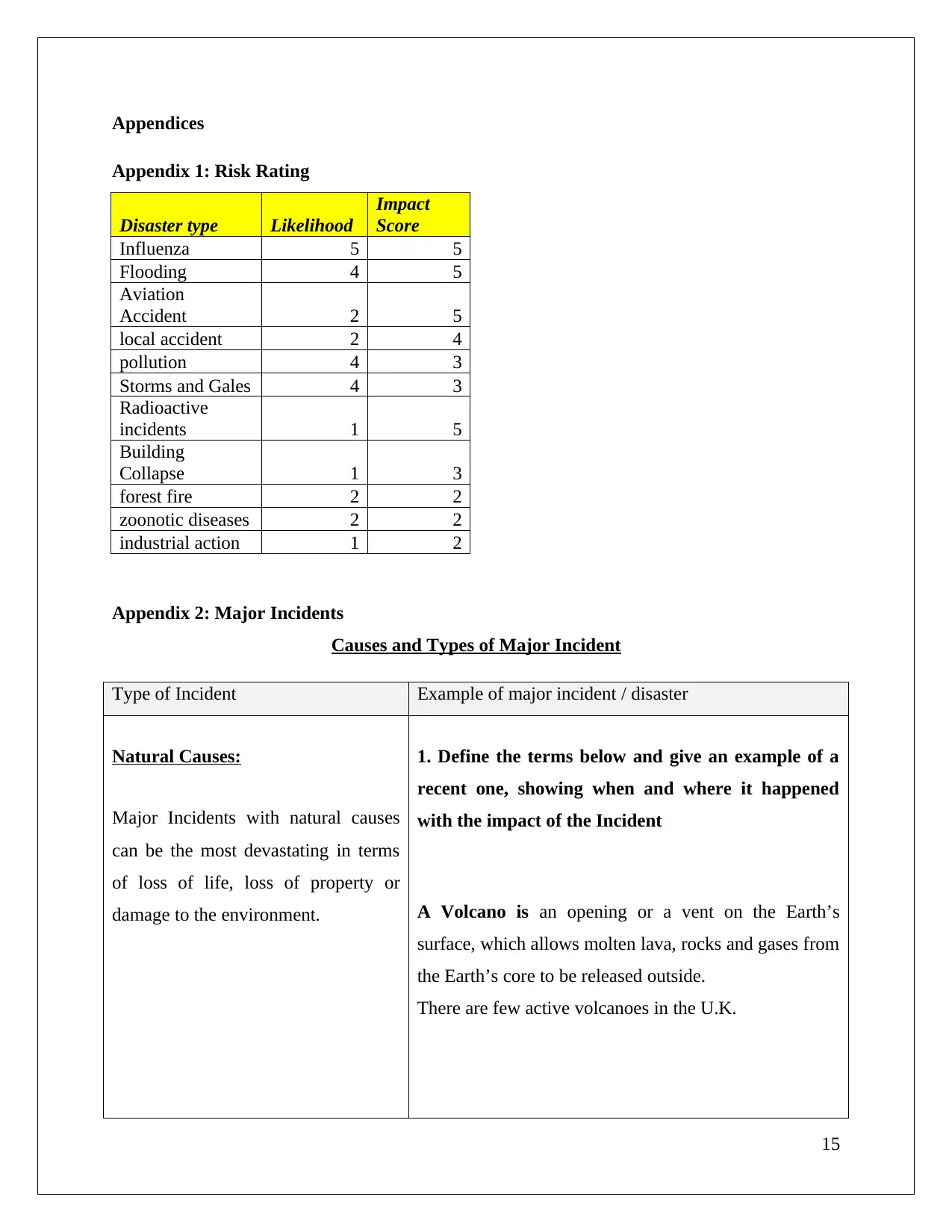
Appendices
Appendix 1: Risk Rating
Disaster type Likelihood
Impact
Score
Influenza 5 5
Flooding 4 5
Aviation
Accident 2 5
local accident 2 4
pollution 4 3
Storms and Gales 4 3
Radioactive
incidents 1 5
Building
Collapse 1 3
forest fire 2 2
zoonotic diseases 2 2
industrial action 1 2
Appendix 2: Major Incidents
Causes and Types of Major Incident
Type of Incident Example of major incident / disaster
Natural Causes:
Major Incidents with natural causes
can be the most devastating in terms
of loss of life, loss of property or
damage to the environment.
1. Define the terms below and give an example of a
recent one, showing when and where it happened
with the impact of the Incident
A Volcano is an opening or a vent on the Earth’s
surface, which allows molten lava, rocks and gases from
the Earth’s core to be released outside.
There are few active volcanoes in the U.K.
15
Appendix 1: Risk Rating
Disaster type Likelihood
Impact
Score
Influenza 5 5
Flooding 4 5
Aviation
Accident 2 5
local accident 2 4
pollution 4 3
Storms and Gales 4 3
Radioactive
incidents 1 5
Building
Collapse 1 3
forest fire 2 2
zoonotic diseases 2 2
industrial action 1 2
Appendix 2: Major Incidents
Causes and Types of Major Incident
Type of Incident Example of major incident / disaster
Natural Causes:
Major Incidents with natural causes
can be the most devastating in terms
of loss of life, loss of property or
damage to the environment.
1. Define the terms below and give an example of a
recent one, showing when and where it happened
with the impact of the Incident
A Volcano is an opening or a vent on the Earth’s
surface, which allows molten lava, rocks and gases from
the Earth’s core to be released outside.
There are few active volcanoes in the U.K.
15
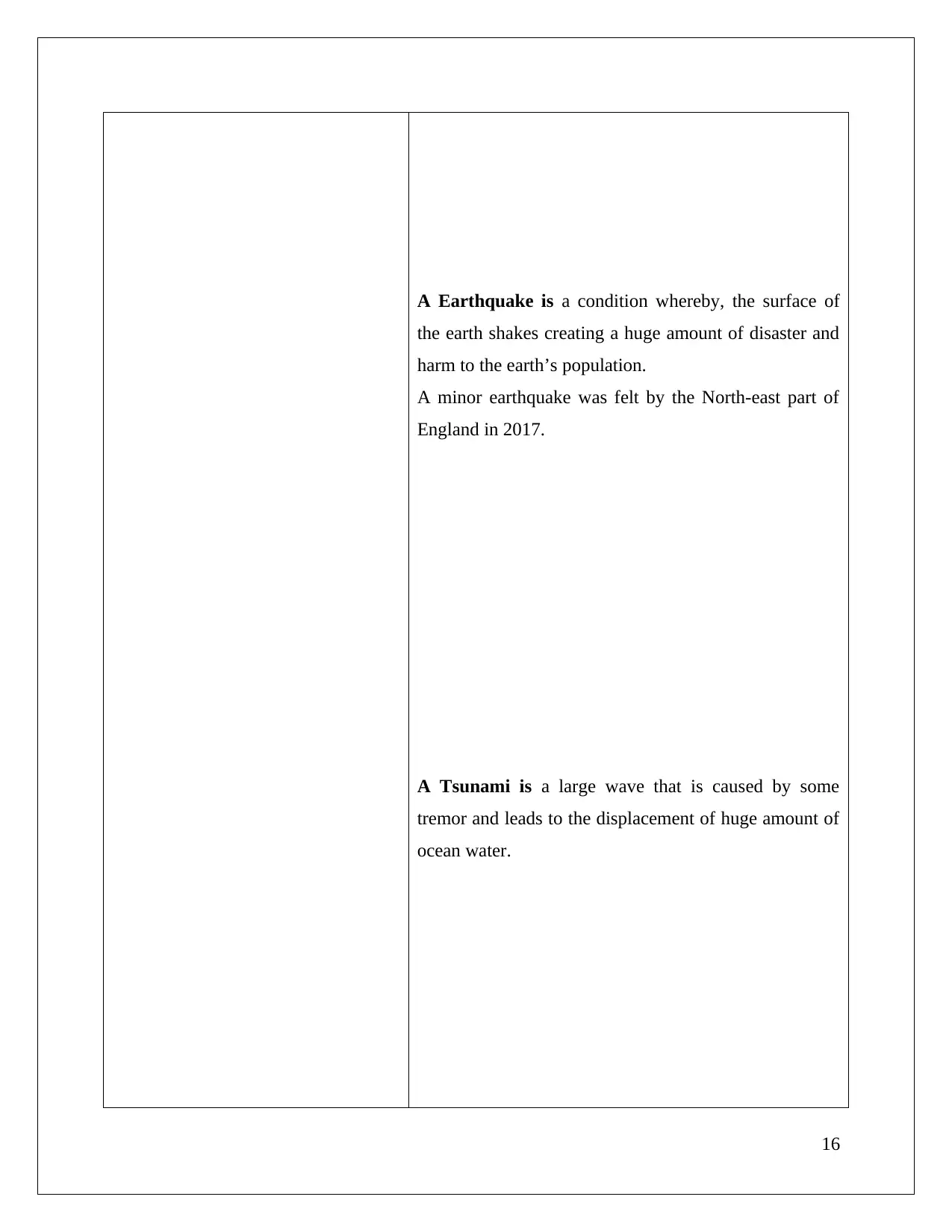
A Earthquake is a condition whereby, the surface of
the earth shakes creating a huge amount of disaster and
harm to the earth’s population.
A minor earthquake was felt by the North-east part of
England in 2017.
A Tsunami is a large wave that is caused by some
tremor and leads to the displacement of huge amount of
ocean water.
16
the earth shakes creating a huge amount of disaster and
harm to the earth’s population.
A minor earthquake was felt by the North-east part of
England in 2017.
A Tsunami is a large wave that is caused by some
tremor and leads to the displacement of huge amount of
ocean water.
16
Secure Best Marks with AI Grader
Need help grading? Try our AI Grader for instant feedback on your assignments.
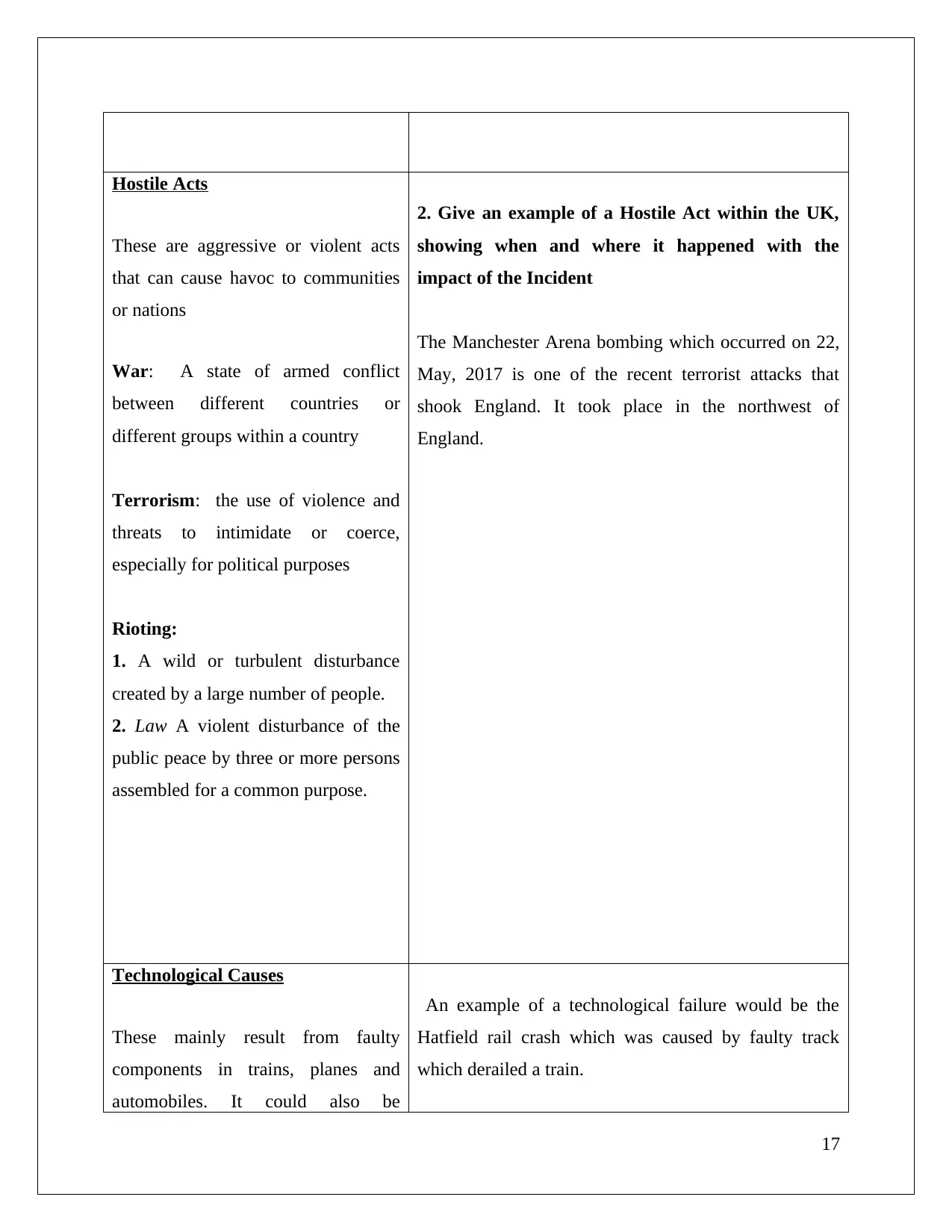
Hostile Acts
These are aggressive or violent acts
that can cause havoc to communities
or nations
War: A state of armed conflict
between different countries or
different groups within a country
Terrorism: the use of violence and
threats to intimidate or coerce,
especially for political purposes
Rioting:
1. A wild or turbulent disturbance
created by a large number of people.
2. Law A violent disturbance of the
public peace by three or more persons
assembled for a common purpose.
2. Give an example of a Hostile Act within the UK,
showing when and where it happened with the
impact of the Incident
The Manchester Arena bombing which occurred on 22,
May, 2017 is one of the recent terrorist attacks that
shook England. It took place in the northwest of
England.
Technological Causes
These mainly result from faulty
components in trains, planes and
automobiles. It could also be
An example of a technological failure would be the
Hatfield rail crash which was caused by faulty track
which derailed a train.
17
These are aggressive or violent acts
that can cause havoc to communities
or nations
War: A state of armed conflict
between different countries or
different groups within a country
Terrorism: the use of violence and
threats to intimidate or coerce,
especially for political purposes
Rioting:
1. A wild or turbulent disturbance
created by a large number of people.
2. Law A violent disturbance of the
public peace by three or more persons
assembled for a common purpose.
2. Give an example of a Hostile Act within the UK,
showing when and where it happened with the
impact of the Incident
The Manchester Arena bombing which occurred on 22,
May, 2017 is one of the recent terrorist attacks that
shook England. It took place in the northwest of
England.
Technological Causes
These mainly result from faulty
components in trains, planes and
automobiles. It could also be
An example of a technological failure would be the
Hatfield rail crash which was caused by faulty track
which derailed a train.
17
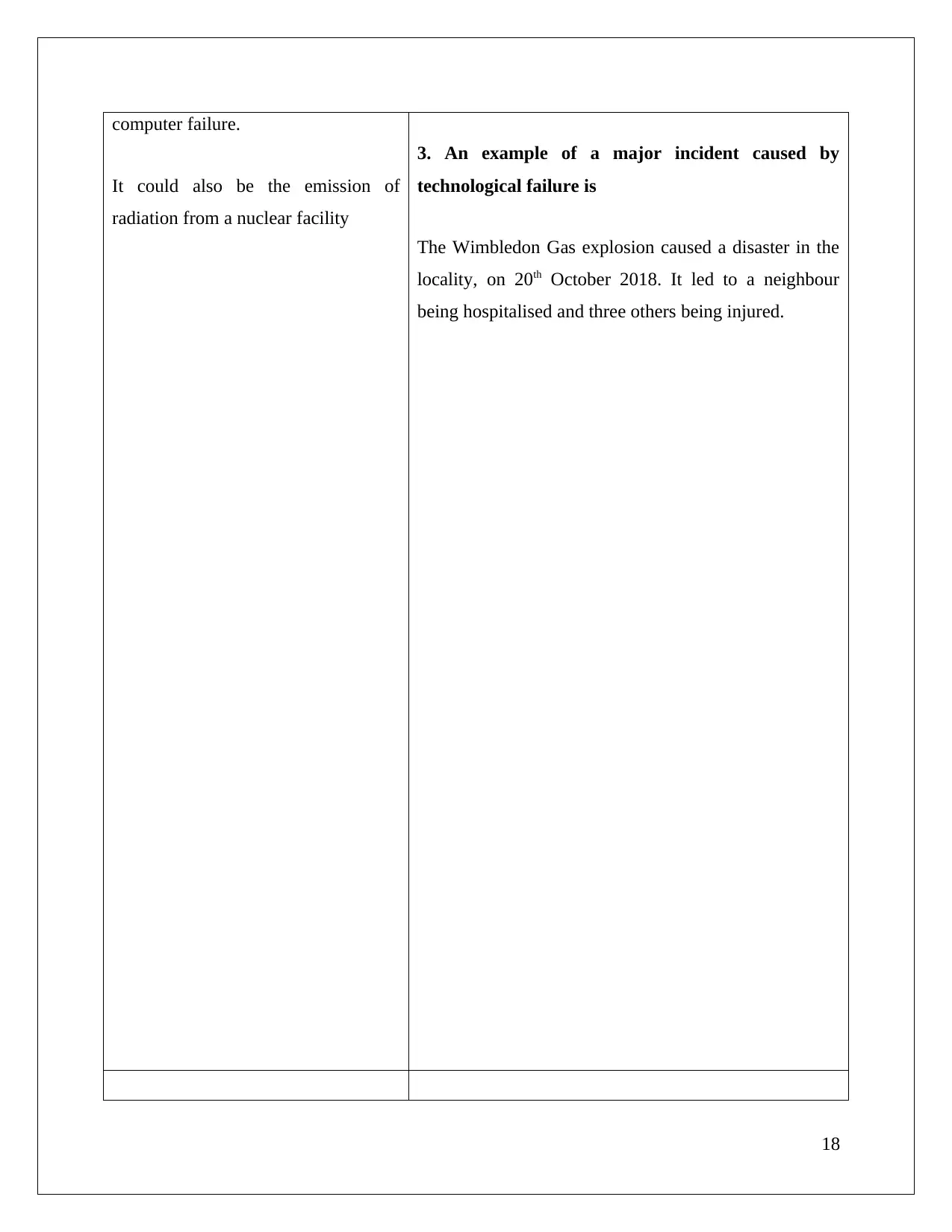
computer failure.
It could also be the emission of
radiation from a nuclear facility
3. An example of a major incident caused by
technological failure is
The Wimbledon Gas explosion caused a disaster in the
locality, on 20th October 2018. It led to a neighbour
being hospitalised and three others being injured.
18
It could also be the emission of
radiation from a nuclear facility
3. An example of a major incident caused by
technological failure is
The Wimbledon Gas explosion caused a disaster in the
locality, on 20th October 2018. It led to a neighbour
being hospitalised and three others being injured.
18
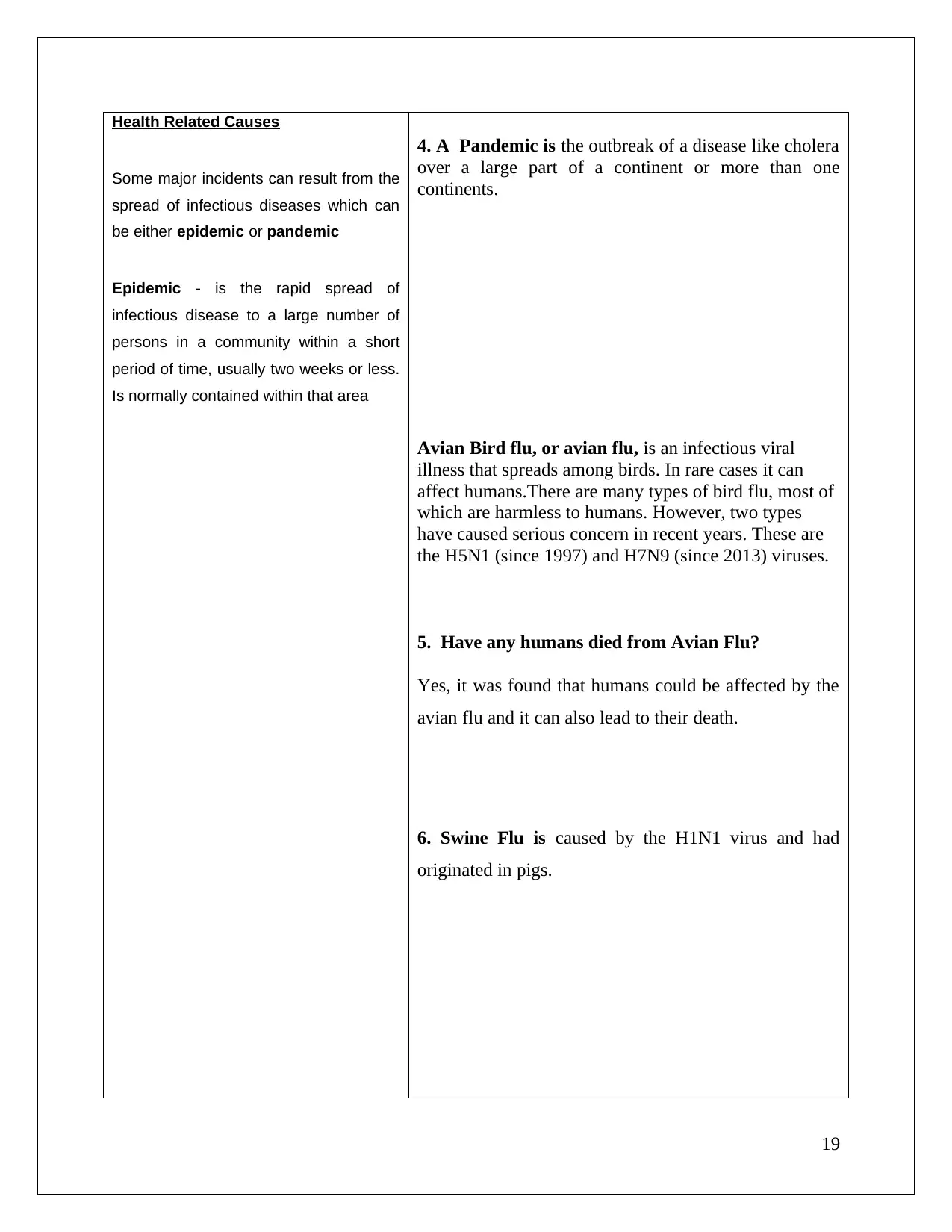
Health Related Causes
Some major incidents can result from the
spread of infectious diseases which can
be either epidemic or pandemic
Epidemic - is the rapid spread of
infectious disease to a large number of
persons in a community within a short
period of time, usually two weeks or less.
Is normally contained within that area
4. A Pandemic is the outbreak of a disease like cholera
over a large part of a continent or more than one
continents.
Avian Bird flu, or avian flu, is an infectious viral
illness that spreads among birds. In rare cases it can
affect humans.There are many types of bird flu, most of
which are harmless to humans. However, two types
have caused serious concern in recent years. These are
the H5N1 (since 1997) and H7N9 (since 2013) viruses.
5. Have any humans died from Avian Flu?
Yes, it was found that humans could be affected by the
avian flu and it can also lead to their death.
6. Swine Flu is caused by the H1N1 virus and had
originated in pigs.
19
Some major incidents can result from the
spread of infectious diseases which can
be either epidemic or pandemic
Epidemic - is the rapid spread of
infectious disease to a large number of
persons in a community within a short
period of time, usually two weeks or less.
Is normally contained within that area
4. A Pandemic is the outbreak of a disease like cholera
over a large part of a continent or more than one
continents.
Avian Bird flu, or avian flu, is an infectious viral
illness that spreads among birds. In rare cases it can
affect humans.There are many types of bird flu, most of
which are harmless to humans. However, two types
have caused serious concern in recent years. These are
the H5N1 (since 1997) and H7N9 (since 2013) viruses.
5. Have any humans died from Avian Flu?
Yes, it was found that humans could be affected by the
avian flu and it can also lead to their death.
6. Swine Flu is caused by the H1N1 virus and had
originated in pigs.
19
Paraphrase This Document
Need a fresh take? Get an instant paraphrase of this document with our AI Paraphraser

7. SARS is a viral disease affecting the respiratory
system of the body. It is caused by SARS coronavirus
and is considered as a zoonotic disease.
8. Ebola is a viral disease outbreak spread by a species
of mosquitoes.
20
system of the body. It is caused by SARS coronavirus
and is considered as a zoonotic disease.
8. Ebola is a viral disease outbreak spread by a species
of mosquitoes.
20

21
1 out of 21
Related Documents
Your All-in-One AI-Powered Toolkit for Academic Success.
+13062052269
info@desklib.com
Available 24*7 on WhatsApp / Email
![[object Object]](/_next/static/media/star-bottom.7253800d.svg)
Unlock your academic potential
© 2024 | Zucol Services PVT LTD | All rights reserved.





